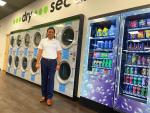CHICAGO — Owning and operating a single laundromat takes plenty of work. Making the decision to build/acquire and run a second store effectively doubles (and perhaps then some?) the ownership challenges one faces day in and day out. But preparing for, acquiring and operating Stores No. 3, 4 and so on seems to get easier with each addition because of experience gained from running their predecessors.
That’s the consensus of several multi-store owners and/or operators interviewed for American Coin-Op. They spoke of the benefits of operational consistency and systemization; their biggest challenge when adding that second store; how technology can simplify multi-store ownership; and more.
Omer Khan and his father Abdul co-own three laundromats south of downtown Atlanta, ranging in size from 3,000 to 8,000 square feet. They’re located about 10 minutes apart from one another, and were recently rebranded Skyline Laundromats (a fourth store is under development). Each is fully attended, employs three to four people, and offers self-service, wash-dry-fold (WDF), and pickup and delivery (PUD).
“They are almost the same, if not very familiar, to each other,” Khan says of the Skylines. “The POS system is all the same in three stores. Everything is systematic, very straightforward.”
Andy Merendino owns three mostly unattended but closely monitored Suds Yer Duds stores in Carneys Point and Pennsville, New Jersey, “all within 20 minutes of home.” Two of them are about 2,600 square feet, while the third is smaller.
“All three are spot-cleaned as needed, then the last few hours (of each day) a cleaner/closer ensures the place is clean, empty and ready for automatic 4 a.m. opening,” Merendino says. “All three are operated similarly with a few variables. The one store has an apartment over it, and the tenant cares for that store. Customers can call us directly at any time to report a problem.”
James (Clark) Sowers and son Randy co-own four differently named laundromats in and around Rapid City, South Dakota. Store sizes range from 2,000 to 4,000 square feet. Two are partly attended, one is fully attended and one is unattended. Altogether, the group employs 12 people plus a part-timer who cleans the unattended store.
“They are operated similarly but yet each with their own identity,” Sowers says. “Same principles, but different demographics.” For example, the Belle Fourche location serves farm, ranch and low-income patrons, while the Spearfish store caters to a wealthier clientele drawn by the local university, business and tourism.
James Radovic owns two fully attended stores in the Florida communities of Jupiter and Stuart that offer self-service and WDF (the Jupiter store also offers PUD). Each covers about 3,000 square feet. Together, they employ 12.
“We try to be as close to the same operation as possible,” he says. “Our pricing is slightly different because of the demographics at each location. We have two identical POS systems which reflect the pricing differences.”
Anne Sechler is operations and marketing manager for Whale of a Wash, a group of eight laundromats located in the eastern panhandle of West Virginia. Average square footage is 1,500 square feet. Three of the stores have dedicated WDF, drycleaning and shirt service operations, while the others are unattended but visited by roving detail cleaners throughout the week.
“Our stores are all operated and run in a similar fashion,” she says. “Hours of operation are similar with the exception of one 24-hour store. All stores get cleaned nightly, we have roughly the same prices across all the stores, and we operate strictly by our mission statement.”
Rex Anderson and his father-in-law, Howard Shear, co-own three Heights Laundry locations (two in Ohio, one in Michigan). All are fully attended and offer self-service and WDF. Store size ranges from roughly 3,500 to 5,000 square feet, with similar equipment mixes. At each, a full-time manager supervises between two and four attendants.
“We find systemization is best,” says Anderson, who also works as controller for Shear’s Lakeside Laundry Equipment distributorship. “We found what works for Heights Laundry 1. Granted, they’re all unique in their own ways. But we’re getting to the point where we have color schemes that we like, layouts that we like when we build them … Our biggest thing is we want customers to walk in and feel comfortable.”
Joe Jepsen, founder of property manager Diamond J Management, owns seven attended O-Town Coin Laundry locations in and around Ogden and Salt Lake City, Utah. Apart from the 6,000-square-foot Salt Lake City flagship, O-Town stores average 3,000 square feet in size. A general manager oversees all stores, and between 40 to 60 attendant work hours is allocated to each (except the largest, which requires at least 80 hours per week).
“Because we have so many locations and plan to do more in the future, standardization is very important to us,” Jepsen says.
In Part 2 on Tuesday: A challenging transition and the helping hand of technology
Have a question or comment? E-mail our editor Bruce Beggs at [email protected].











